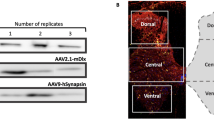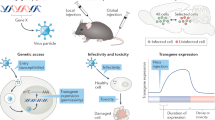Abstract
We, like many others, wish to use modern molecular methods to alter neuronal functionality in primates. For us, this requires expression in a large proportion of the targeted cell population. Long generation times make germline modification of limited use. The size and intricate primate brain anatomy poses additional challenges. We surved methods using lentiviruses and serotypes of adeno-associated viruses (AAVs) to introduce active molecular material into cortical and subcortical regions of old-world monkey brains. Slow injections of AAV2 give well-defined expression of neurons in the cortex surrounding the injection site. Somewhat surprisingly we find that in the monkey the use of cytomegalovirus promoter in lentivirus primarily targets glial cells but few neurons. In contrast, with a synapsin promoter fragment the lentivirus expression is neuron specific at high transduction levels in all cortical layers. We also achieve specific targeting of tyrosine hydroxlase (TH)- rich neurons in the locus coeruleus and substantia nigra with a lentvirus carrying a fragment of the TH promoter. Lentiviruses carrying neuron specific promoters are suitable for both cortical and subcortical injections even when injected quickly.
This is a preview of subscription content, access via your institution
Access options
Subscribe to this journal
Receive 12 print issues and online access
$259.00 per year
only $21.58 per issue
Buy this article
- Purchase on Springer Link
- Instant access to full article PDF
Prices may be subject to local taxes which are calculated during checkout





Similar content being viewed by others
References
Byrne BJ, Falk DJ, Clement N, Mah CS . Gene therapy approaches for lysosomal storage disease: next-generation treatment. Hum Gene Ther 2012; 23: 808–815.
Prickett M, Jain M . Gene therapy in cystic fibrosis. Transl Res 2012; 161: 255–264.
Gavrilov K, Saltzman WM . Therapeutic siRNA: principles, challenges, and strategies. Yale J Biol Med 2012; 85: 187–200.
Zhou J, Rossi JJ . Current progress in the development of RNAi-based therapeutics for HIV-1. Gene Ther 2011; 18: 1134–1138.
Poewe W, Mahlknecht P, Jankovic J . Emerging therapies for Parkinson's disease. Curr Opin Neurol 2012; 25: 448–459.
Tye KM, Deisseroth K . Optogenetic investigation of neural circuits underlying brain disease in animal models. Nat Rev. Neurosci 2012; 13: 251–266.
Farrell MS, Roth BL . Pharmacosynthetics: Reimagining the pharmacogenetic approach. Brain Res 2013 1511: 6–20.
Shapiro MG, Frazier SJ, Lester HA . Unparalleled control of neural activity using orthogonal pharmacogenetics. ACS Chem Neurosci 2012; 3: 619–629.
Chaudhury D, Walsh JJ, Friedman AK, Juarez B, Ku SM, Koo JW et al. Rapid regulation of depression-related behaviours by control of midbrain dopamine neurons. Nature 2013; 493: 532–536.
Ferguson SM, Eskenazi D, Ishikawa M, Wanat MJ, Phillips PE, Dong Y et al. Transient neuronal inhibition reveals opposing roles of indirect and direct pathways in sensitization. Nat neurosci 2011; 14: 22–24.
Lee SH, Kwan AC, Zhang S, Phoumthipphavong V, Flannery JG, Masmanidis SC et al. Activation of specific interneurons improves V1 feature selectivity and visual perception. Nature 2012; 488: 379–383.
Fenno L, Yizhar O, Deisseroth K . The development and application of optogenetics. Annu Rev Neurosci 2011; 34: 389–412.
Podolska K, Stachurska A, Hajdukiewicz K, Malecki M . Gene therapy prospects-intranasal delivery of therapeutic genes. Adv Clin Exp Med: 2012; 21: 525–534.
Dayton RD, Wang DB, Klein RL . The advent of AAV9 expands applications for brain and spinal cord gene delivery. Expert Opin Biol Ther 2012; 12: 757–766.
Tye KM, Mirzabekov JJ, Warden MR, Ferenczi EA, Tsai HC, Finkelstein J et al. Dopamine neurons modulate neural encoding and expression of depression-related behaviour. Nature 2012; 493: 537–541.
Warden MR, Selimbeyoglu A, Mirzabekov JJ, Lo M, Thompson KR, Kim SY et al. A prefrontal cortex-brainstem neuronal projection that controls response to behavioural challenge. Nature 2012; 492: 428–432.
Liu X, Ramirez S, Pang PT, Puryear CB, Govindarajan A, Deisseroth K et al. Optogenetic stimulation of a hippocampal engram activates fear memory recall. Nature 2012; 484: 381–385.
Nayerossadat N, Maedeh T, Ali PA . Viral and nonviral delivery systems for gene delivery. Adv Biomed Res 2012; 1: 27.
Bankiewicz KS, Leff SE, Nagy D, Jungles S, Rokovich J, Spratt K et al. Practical aspects of the development of ex vivo and in vivo gene therapy for Parkinson's disease. Exp Neurol 1997; 144: 147–156.
Dissen GA, Lomniczi A, Neff TL, Hobbs TR, Kohama SG, Kroenke CD et al. In vivo manipulation of gene expression in non-human primates using lentiviral vectors as delivery vehicles. Methods 2009; 49: 70–77.
Sanftner LM, Sommer JM, Suzuki BM, Smith PH, Vijay S, Vargas JA et al. AAV2-mediated gene delivery to monkey putamen: evaluation of an infusion device and delivery parameters. Exp Neurol 2005; 194: 476–483.
Su X, Kells AP, Salegio EA, Richardson RM, Hadaczek P, Beyer J et al. Real-time MR imaging with Gadoteridol predicts distribution of transgenes after convection-enhanced delivery of AAV2 vectors. Molul Ther 2010; 18: 1490–1495.
Diester I, Kaufman MT, Mogri M, Pashaie R, Goo W, Yizhar O et al. An optogenetic toolbox designed for primates. Nat Neurosci 2011; 14: 387–397.
Jazayeri M, Lindbloom-Brown Z, Horwitz GD . Saccadic eye movements evoked by optogenetic activation of primate V1. Nat Neurosci 2012; 15: 1368–1370.
Cavanaugh J, Monosov IE, McAlonan K, Berman R, Smith MK, Cao V et al. Optogenetic inactivation modifies monkey visuomotor behavior. Neuron 2012; 76: 901–907.
Han X, Chow BY, Zhou H, Klapoetke NC, Chuong A, Rajimehr R et al. A high-light sensitivity optical neural silencer: development and application to optogenetic control of non-human primate cortex. Front Syst Neurosci 2011; 5: 18.
Cearley CN, Wolfe JH . Transduction characteristics of adeno-associated virus vectors expressing cap serotypes 7, 8, 9, and Rh10 in the mouse brain. Molul Ther 2006; 13: 528–537.
Salegio EA, Samaranch L, Kells AP, Forsayeth J, Bankiewicz K . Guided delivery of adeno-associated viral vectors into the primate brain. Adv Drug Deliv Rev 2012; 64: 598–604.
Mullen RJ, Buck CR, NeuN Smith AM . a neuronal specific nuclear protein in vertebrates. Development 1992; 116: 201–211.
Ribak CE . Aspinous and sparsely-spinous stellate neurons in the visual cortex of rats contain glutamic acid decarboxylase. J Neurocytol 1978; 7: 461–478.
Liu Z, Richmond BJ, Murray EA, Saunders RC, Steenrod S, Stubblefield BK et al. DNA targeting of rhinal cortex D2 receptor protein reversibly blocks learning of cues that predict reward. Proc Natl Acad Sci USA 2004; 101: 12336–12341.
Lerchner W, Xiao C, Nashmi R, Slimko EM, van Trigt L, Lester HA et al. Reversible silencing of neuronal excitability in behaving mice by a genetically targeted, ivermectin-gated Cl- channel. Neuron 2007; 54: 35–49.
Kumar M, Keller B, Makalou N, Sutton RE . Systematic determination of the packaging limit of lentiviral vectors. Hum Gene Ther 2001; 12: 1893–1905.
Han X, Qian X, Bernstein JG, Zhou HH, Franzesi GT, Stern P et al. Millisecond-timescale optical control of neural dynamics in the nonhuman primate brain. Neuron 2009; 62: 191–198.
Krauze MT, Saito R, Noble C, Tamas M, Bringas J, Park JW et al. Reflux-free cannula for convection-enhanced high-speed delivery of therapeutic agents. J Neurosurg 2005; 103: 923–929.
National Research Council of the National Academies Guide for the Care and Use of Laboratory Animals, 8th edn The National Academy Press: Washington, DC, USA, 2011.
Turchi J, Saunders RC, Mishkin M . Effects of cholinergic deafferentation of the rhinal cortex on visual recognition memory in monkeys. Proc Natl Acad Sci USA 2005; 102: 2158–2161.
Ravel S, Richmond BJ . Dopamine neuronal responses in monkeys performing visually cued reward schedules. Eur J Neurosci 2006; 24: 277–290.
Bouret S, Richmond BJ . Relation of locus coeruleus neurons in monkeys to Pavlovian and operant behaviors. J neurophysiol 2009; 101: 898–911.
Rosene DL, Roy NJ, Davis BJ . A cryoprotection method that facilitates cutting frozen sections of whole monkey brains for histological and histochemical processing without freezing artifact. J Histochem Cytochem 1986; 34: 1301–1315.
Lidow MS, Goldman-Rakic PS, Rakic P, Innis RB . Dopamine D2 receptors in the cerebral cortex: distribution and pharmacological characterization with [3H]raclopride. Proc Natl Acad Sci USA 1989; 86: 6412–6416.
Smiley JF, Levey AI, Ciliax BJ, Goldman-Rakic PS . D1 dopamine receptor immunoreactivity in human and monkey cerebral cortex: predominant and extrasynaptic localization in dendritic spines. Proc Natl Acad Sci USA 1994; 91: 5720–5724.
Acknowledgements
We thank Sebastien Bouret for crucial help with locating and injecting the locus coeruleus, and Rachel Reoli for her kind support with MRI scans. This study was supported by the Intramural Research Program of the National Institute of Mental Health.
DISCLAIMER
The views expressed in this article do not necessarily represent the views of the NIMH, NIH or the United States Government.
Author information
Authors and Affiliations
Corresponding author
Ethics declarations
Competing interests
The authors declare no conflict of interest.
Additional information
Supplementary Information accompanies this paper on Gene Therapy website
Rights and permissions
About this article
Cite this article
Lerchner, W., Corgiat, B., Der Minassian, V. et al. Injection parameters and virus dependent choice of promoters to improve neuron targeting in the nonhuman primate brain. Gene Ther 21, 233–241 (2014). https://doi.org/10.1038/gt.2013.75
Received:
Revised:
Accepted:
Published:
Issue Date:
DOI: https://doi.org/10.1038/gt.2013.75
Keywords
This article is cited by
-
RNAi and chemogenetic reporter co-regulation in primate striatal interneurons
Gene Therapy (2022)
-
Advances in optogenetic and chemogenetic methods to study brain circuits in non-human primates
Journal of Neural Transmission (2018)
-
Therapeutic potential of combined viral transduction and CRISPR/Cas9 gene editing in treating neurodegenerative diseases
Neurological Sciences (2018)
-
PET imaging-guided chemogenetic silencing reveals a critical role of primate rostromedial caudate in reward evaluation
Nature Communications (2016)
-
Chemogenetic disconnection of monkey orbitofrontal and rhinal cortex reversibly disrupts reward value
Nature Neuroscience (2016)



